Ask a question from expert
Internationalization of SMEs
74 Pages18694 Words461 Views
Added on 2019-09-18
Internationalization of SMEs
Added on 2019-09-18
BookmarkShareRelated Documents
Running Head: InternationalizationSTRATEGIES FOR SMALL AND MEDIUM ENTERPRISEINTERNATIONALIZATION AND BARRIERS OFINTERNATIONALIZATION AND EXPORT PERFORMANCE OFLOCAL AGRICULTURAL BUSINESSES IN NIGERIAName:Year:
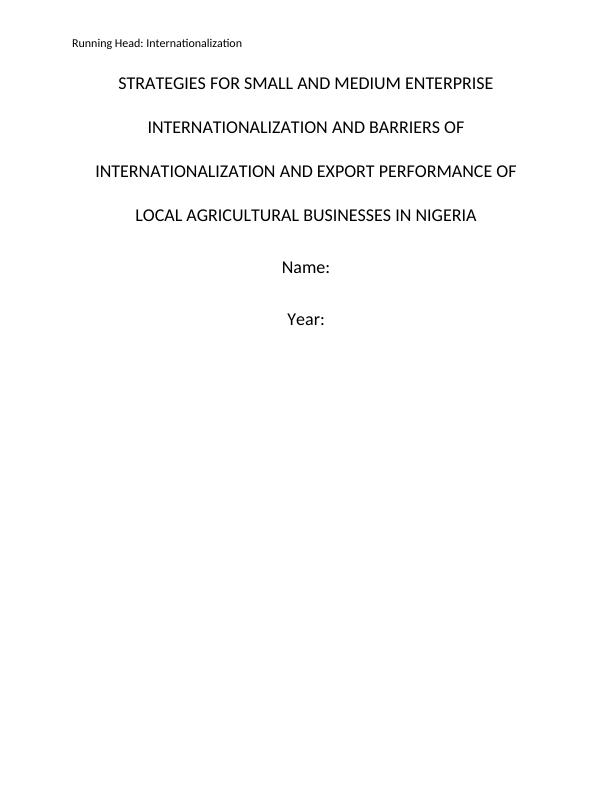
InternationalizationAbstractInternationalization is an effective strategy that enables the small and medium enterprises(SMEs) across the world. Entering the international market enables the SMEs to tap the largercustomer base and increase the profitability. However, for operating in the internationalmarket successfully, the businesses need to have innovative strategies and advancedinfrastructure. The SMEs often lack adequate resources and innovative ideas and so, theseorganizations fail to operate in the international market successfully. The agricultural SMEs inNigeria face intense competition in the domestic market. So, the organizations are focusing onentering the international market. In the current research, survey is conducted among theprofessionals who are involved to the agricultural businesses. The findings of survey, afterthematic analysis of the responses, indicate that the lack of knowledge, financial resources,innovative ideas and advanced technology are the key barriers to internationalization.Operating in the international market would be easier if the businesses invest in e-commercetechnology and market research.2
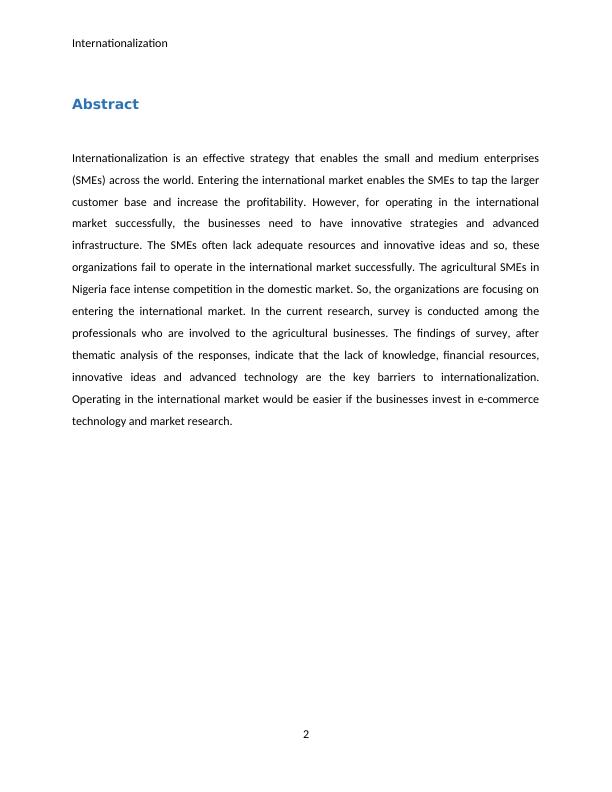
InternationalizationAcknowledgementIwould like to express my special thanks of gratitude to my teacher who gave me the goldenopportunity to do this wonderful project on the topic,STRATEGIES FOR SMALL AND MEDIUMENTERPRISE INTERNATIONALIZATION AND BARRIERS OF INTERNATIONALIZATION ANDEXPORT PERFORMANCE OF LOCAL AGRICULTURAL BUSINESSES IN NIGERIA, which also helpedme in doing a lot of Research and I came to know about so many new things I am reallythankful.3

InternationalizationContentsAbstract............................................................................................................................................2Acknowledgement...........................................................................................................................3Chapter 1: Introduction...................................................................................................................61. Introduction.............................................................................................................................61.1 Aim and Objectives of the Research......................................................................................71.2 Research Question.................................................................................................................81.3 Outline of the Research.........................................................................................................91.4 Literature Review.................................................................................................................101.5 Methodology........................................................................................................................111.7 Barriers of Internationalization and Export Performance of Local Agricultural Businesses inNigeria........................................................................................................................................121.8 Conclusion............................................................................................................................13Chapter 2: Literature Review.........................................................................................................142.1 Introduction to The Nigerian Agribusiness industry............................................................142.2 Internationalization and its benefits in SMEs......................................................................152.3 Barriers of SMEs Internationalization..................................................................................152.4 Need for internationalization...............................................................................................212.5 Conceptual framework........................................................................................................232.6 Organization Readiness........................................................................................................272.7 Conclusion............................................................................................................................28Chapter 3: Research Methodology................................................................................................293.1 Introduction.........................................................................................................................294
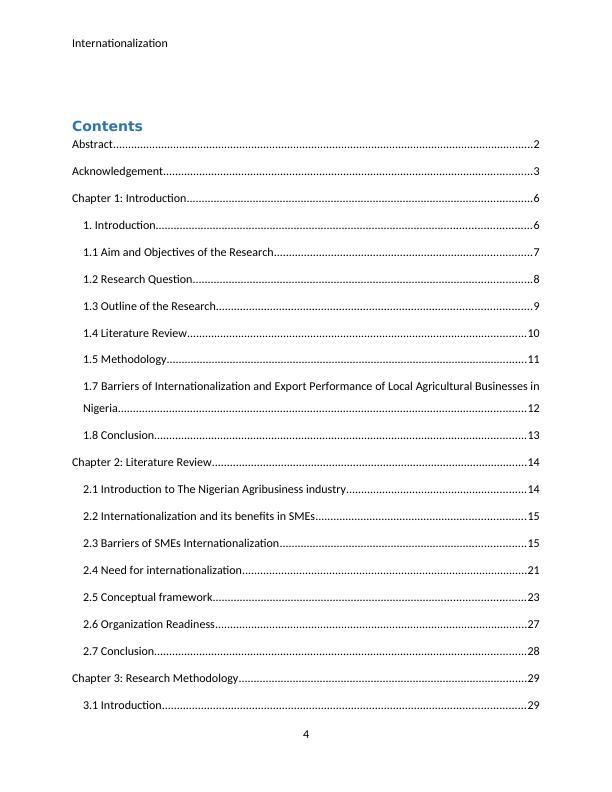
Internationalization3.2 Research Objectives.............................................................................................................303.3 Research Question...............................................................................................................313.4 Research Method.................................................................................................................313.5 Research Design...................................................................................................................323.6 Research Approach..............................................................................................................333.7 Research Philosophy............................................................................................................343.8 Sampling Technique.............................................................................................................363.9 Data Collection Technique...................................................................................................373.10 Data Evaluation Technique................................................................................................383.11 Ethical Consideration.........................................................................................................393.12 Validity and reliability........................................................................................................393.13 Limitation of study.............................................................................................................40CHAPTER 4: DATA ANALYSIS..........................................................................................................424.1 Introduction.........................................................................................................................424.2 Presentation of Data............................................................................................................424.3 Analysis.................................................................................................................................504.4 Conclusion............................................................................................................................52Chapter 5: Conclusion....................................................................................................................535.1 Introduction.........................................................................................................................535.2 Linking to Objectives............................................................................................................535.3 Recommendations...............................................................................................................575.4 Chapter Summary................................................................................................................58Appendix 1: Survey Questionnaire and Responses.......................................................................695
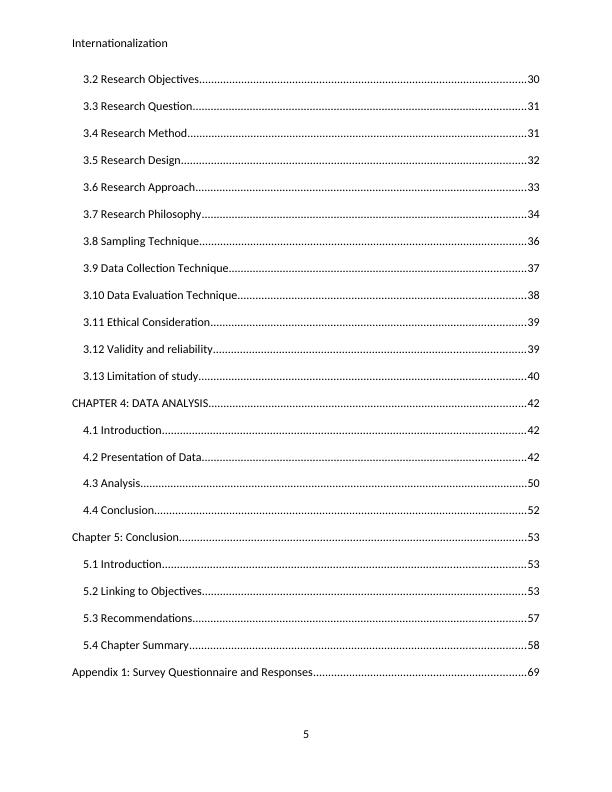
Internationalization6

InternationalizationChapter 1: Introduction1. IntroductionSmall and medium-sized enterprises are some of the most effective sources of growth foradvanced industrialized countries and for emerging countries alike. The underlying growthprospects in such kinds of enterprises are huge compared to large organization. SMEs havegained recognition over time with their own characteristics (Dimitratos et al., 2016). Theagencies are considered as one of the large parts of the private sector of the developed anddeveloping countries. However, it was seen that SMEs have a causal link with economicdevelopment as there is evidence that show that small firms usually faces larger growthconstraints than the big firms due to less access to external finance (Eniola&Ektebang, 2014).Internationalization is usually denoted by big business; however, it is slowly being carried outby the small business as well with their limited resources (Dimitratos et al., 2016). The reasonbehind internationalization is to increase sales, diversify associated risks and operation, gettingbetter clients, reduces costs and other benefits for business. The agricultural sector of Nigeriahas always faced with issues such as the lack of development, marketing problems, unstableprices and others (Eriksson et al., 2015). Nigerian cultivation perseveres through the disastersas much as possible for the vegetables, 30% for roots and tubers, and 20% for grains (FMARD,2001). Internationalization will help them to improve on these potential barriers so that theycan experience continuous growth. The agricultural sector of Nigeria is experiencing a lowerdevelopment and growth rate over decades with an average growth rate standing at 6 to 8percent per year. Thus, it became necessary to research the strategies that small and medium-7

Internationalizationsize enterprise like the agricultural production of Nigeria can use to promote theirinternationalization process and solve the issues they are facing such as growth sales andprofitability. 1.1 Aim and Objectives of the ResearchThe aim and objectives of the dissertation will help in offering a clear view to the research onstrategies for small and medium enterprises internationalization and barriers ofinternationalization with reference to export performance of local agricultural businesses in adeveloping country like Nigeria and areas that need to be achieved through thorough researchand analysis. AIM: The research aims at examining the strategies that SMEs can use to internationalize thelocal agricultural production in Nigeria. The research focuses on identifying the ways in whichthe small and medium sector enterprise can grow internationally. The research also aims athow the SMEs in Nigeria deal with the financial constraints. This study will explore whethersimilar strategies can be implemented in the SMEs of Nigeria. OBJECTIVES: The objectives of the research are as follows:• To study the internationalization process: Industrialization has various meanings as it isunderstood by different people on a different sphere. Understanding internationalization willbe the first and the foremost aim of the paper as without understanding this term it will bedifficult to set the strategies that can help attain the industrialization. 8
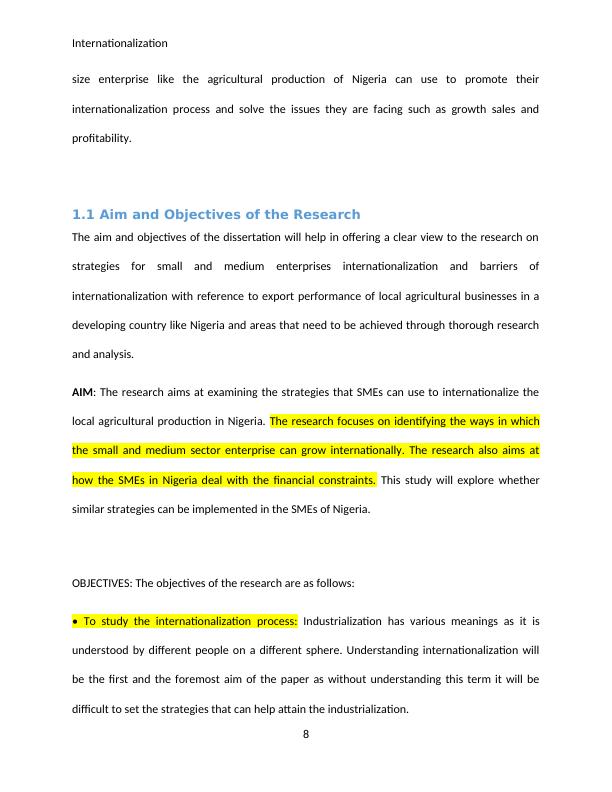
End of preview
Want to access all the pages? Upload your documents or become a member.
Related Documents
Barriers of Internationalization Assignmentlg...
|77
|19941
|296
Internationalization Enable to Small and Medium Enterprise | Assignmentlg...
|74
|18880
|312
Internationalization and Its Barriers Assignmentlg...
|77
|19941
|63
Small And Medium Enterprise Internationalization| Strategies & Barrierslg...
|76
|19415
|60
Strategies for Small and Medium Enterprise Internationalization and Barriers of Internationalization and Export Performance of Local Agricultural Businesses in Nigerialg...
|77
|19941
|225
Assignment on Small and Medium sized Enterpriseslg...
|10
|2746
|256